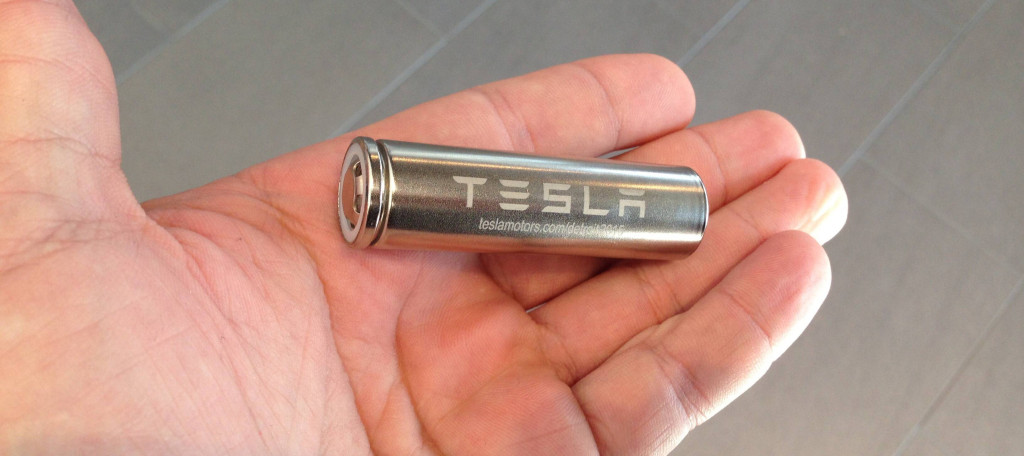Tech
Tesla patents new chemistry for better, longer-lasting and cheaper batteries – Electrek

Tesla has made a lot of battery moves this year and it is closing the year by filing a patent on a new chemistry for better, longer-lasting and cheaper batteries.
Earlier this year, we reported on Tesla’s battery research partner, Jeff Dahn and his team at Dalhousie University, unveiling the impressive results of tests on a new battery cell that could last over 1 million miles in an electric vehicle.
The new battery tested is a Li-Ion battery cell with a next-generation “single crystal” NMC cathode and a new advanced electrolyte.
Since then, Tesla has been filing US and international patents on the new battery chemistry.
The automaker, through its ‘Tesla Motors Canada’ subsidiary, filed a new international patent called ‘Dioxazolones and nitrile sulfites as electrolyte additives for lithium-ion batteries’.
They wrote in the patent application:
“This disclosure covers novel battery systems with fewer operative, electrolyte additives that may be used in different energy storage applications, for example, in vehicle and grid-storage. More specifically, this disclosure includes additive electrolyte systems that enhance performance and lifetime of lithium-ion batteries, while reducing costs from other systems that rely on more or other additives.”
Tesla wrote in the conclusion of the patent application for the new battery chemistry:
“This work characterizes the high temperature storage and long-term cycling performance of lithium-ion NMC/graphite pouch cells prepared with a recently developed electrolyte additive, MDO, and two new additives, PDO and BS. Differential capacity versus voltage indicates that both MDO and PDO form passive SEI layers on the graphite electrode surface during cell formation, whereas BS does not. The reduction features are generally consistent with DFT-predicted values, although the presence of multiple reduction peaks requires additional study to rationalize. As individual additives, PDO-containing cells show the best performance although these are nonetheless out-performed by VC-containing cells. The additives were also tested in binary blends with VC, DTD, and LFO. In long-term cycling tests, cells prepared with 2%PDO/l%DTD and 2%PDO/l%LFO additive blends outperform VC-containing cells. However, the high temperature storage behavior of 2%PDO/l%LFO is superior than that of the 2%PDO/l%DTD blend. A person of skill in the art will understand that compositions described herein may be further optimized, for example, by adjusting the ratio of primary and secondary additives or through introducing ternary blends.”
The patent application says that the new two-additive mixtures in an electrolyte solvent can be used with lithium nickel manganese cobalt compounds, also known as an NMC battery chemistry.
It is commonly used in electric vehicles by many automakers, but not by Tesla. The company used the technology in its stationary energy storage systems, but it uses NCA for its vehicle battery cells.
The patent filed by Tesla’s battery research group mentions that the technology would be useful for both electric vehicles and grid-storage.
Interestingly, Tesla has been rumored to be switching to NCM battery cells for Chinese Model 3 vehicles.
Tesla has been filing new battery patents as it has also been making moves toward building its own battery cells.
Earlier this year, Tesla CEO Elon Musk said that they built Model 3 to last as long as a commercial truck, a million miles, and the battery modules should last between 300,000 miles and 500,000 miles.
However, the CEO claimed that Tesla has a new battery coming up next year that will last a million miles.
Here’s Tesla’s full patent application:
FTC: We use income earning auto affiliate links. More.
Subscribe to Electrek on YouTube for exclusive videos and subscribe to the podcast.
Tech
The Ultimate Recap of Sea Otter 2024 – Pinkbike.com


Vittoria Releases New Peyote & Mezcal XC Race Tires
Maxxis Team Spec Aspen ST Tire
New DT Swiss 240 DEG Hubs
Kali Protectives’ New Full Face Helmets
Industry Nine’s SOLiX M Hubs & Wheelsets
Michelin’s Aggressive New Wild Enduro Tires
Praxis’ New Flat Pedals, Stem, & Carbon Bottle Cage
Transmission Cage Upgrades from Kogel, Ceramicspeed, and Cascade Components
Randoms Round 1 – Sea Otter 2024
Madrone Cycles’ SRAM Eagle Repair Kits & Prototype Derailleur
Vorsprung’s New Telum Coil Shock
EXT’s Vaia Inverted DH Fork & Updated Coil Shocks
Randoms Round 2: New Tools, Goggles, Grips, Racks, & More – Sea Otter 2024
What’s New in Women’s MTB Apparel at Sea Otter 2024
Even More Randoms – Sea Otter 2024
Randoms Round 3: Dario’s Treasures
What’s New for the Kids at Sea Otter 2024
Deity Releases New Stems, Grips, & Pedals
Dario’s Final Sea Otter Randoms
Brian’s Randoms from Sea Otter 2024
Videos
With roots dating back to 1991, the Sea Otter Classic is one of the biggest biking events and tradeshows each year and brings together all sides of the biking industry from athletes to brands, spectators and consumers. Taking place in April in the sunny hills of Monterey, California, that means this event really feels like the official start to the biking season in North America. Christina Chappetta covers why it’s much different to an indoor European biking tradeshow, a World Cup racing weekend or even Crankworx mountain bike festival, in that it encompasses nearly ALL of the biking disciplines, including road cycling, enduro, downhill, dual slalom, XC, trials riding and more.
In the past fortnight, we have seen large amount of new tech releases. However, Sea Otter 2024 represents some of the first opportunities for many riders to see these things in the flesh, as well as take a deeper dive into what the product aims to do.
Welcome to a video summary from Day 2 of the Sea Otter Classic.
There are so many giveaways, interesting new products and colourful characters at Sea Otter Classic that it’s hard to stand out from the crowd. Ben Cathro takes a lap of the venue to find his favourites.
Tech
Apple iPad Air 2024: Insider Makes Hasty U-Turn On New Feature – Forbes


Well, that was quick. On May 18, a respected industry insider predicted a new display technology for the iPad Air that’s expected in the coming days—Apple just announced its latest special event.
The new 12.9-inch iPad Air, the report claimed, would have the same miniLED backlighting currently found on the larger iPad Pro, using the leftover inventory from the current Pro as that model switches to OLED. That was exciting news.
But now, Ross Young, the analyst who made the claim, has changed his mind. The new prediction, shared with paid subscribers only, is that the miniLED technology won’t be coming to the iPad Air, in either size.
While it made sense that the inventory could be maximized in this way, it now “makes sense” that it won’t.
Young says that while he’d heard from supply chain sources that it would, he’d now had contact from “even more supply chain sources” that it won’t.
And the reason this change of heart now makes sense is that this miniLED technology is expensive, so it would be surprising if it made it to the iPad Air, which is more affordable than the Pro.
That’s not quite all the analyst shared. He also said that there are now reports of a new iPad coming later in the year. This is a 12.9-inch iPad, with miniLED backlighting and it could arrive between October and December this year.
function loadConnatixScript(document)
if (!window.cnxel)
window.cnxel = ;
window.cnxel.cmd = [];
var iframe = document.createElement(‘iframe’);
iframe.style.display = ‘none’;
iframe.onload = function()
var iframeDoc = iframe.contentWindow.document;
var script = iframeDoc.createElement(‘script’);
script.src = ‘//cd.elements.video/player.js’ + ‘?cid=’ + ’62cec241-7d09-4462-afc2-f72f8d8ef40a’;
script.setAttribute(‘defer’, ‘1’);
script.setAttribute(‘type’, ‘text/javascript’);
iframeDoc.body.appendChild(script);
;
document.head.appendChild(iframe);
loadConnatixScript(document);
(function()
function createUniqueId()
return ‘xxxxxxxx-xxxx-4xxx-yxxx-xxxxxxxxxxxx’.replace(/[xy]/g, function(c)
var r = Math.random() * 16 );
const randId = createUniqueId();
document.getElementsByClassName(‘fbs-cnx’)[0].setAttribute(‘id’, randId);
document.getElementById(randId).removeAttribute(‘class’);
(new Image()).src = ‘https://capi.elements.video/tr/si?token=’ + ’44f947fb-a5ce-41f1-a4fc-78dcf31c262a’ + ‘&cid=’ + ’62cec241-7d09-4462-afc2-f72f8d8ef40a’;
cnxel.cmd.push(function ()
cnxel(
playerId: ’44f947fb-a5ce-41f1-a4fc-78dcf31c262a’,
playlistId: ‘aff7f449-8e5d-4c43-8dca-16dfb7dc05b9’,
).render(randId);
);
)();
This is intriguing. What could it be? Assuming that the iPad Pro and iPad Air are released in May, it’s extremely unlikely either will be updated later in the year. And if the iPad Air isn’t pricey enough for miniLED to be included, what tablet could Apple be introducing that is the same size as the bigger Pro, with a pricey screen tech, which would sit between the Air and the Pro, it seems?
Young is highly reliable, but this seems slightly preposterous to me. The only other iPad in the range due a refresh is the regular iPad (at 12.9-inches, the iPad mini is clearly out of the picture) and that doesn’t seem likely either.
It seems to me that any regular iPad will almost certainly have the same screen size as now, 10.9 inches. The regular iPad only grew to this size screen in the current generation, and Apple almost never changes designs after one iteration.
Perhaps things will become clearer as the year goes on.
Tech
Woman who left beaten dad on floor for 2 days was 'overwhelmed' with his care, judge told – CBC.ca


A Calgary woman who abused her sick, 77-year-old father was “overwhelmed” at the task of caring for him, a judge heard Wednesday at a sentencing hearing.
In January, Tara Picard, 52, pleaded guilty to charges of assault and failing to provide the necessaries of life after her father (whom CBC News is not naming) was found injured on a basement floor, where he’d been lying for two days.
On Wednesday, prosecutor Donna Spaner and defence lawyer Shaun Leochko asked the judge to allow Picard to serve her sentence in the community under conditions as part of a conditional sentence order.
Justice Indra Maharaj agreed to a two-year conditional sentence for Picard followed by a year of probation.
“There is no doubt she became overwhelmed,” said Spaner in her submissions. “There is no question Ms. Picard has remorse.”
Leochko told the judge that caring for her father “was really more than [Picard] could handle.”
Maharaj heard that Picard is Indigenous and was the victim of abuse growing up. She lives in a sober dorm-style facility and is working with a mental health and addictions navigator, according to Leochko.
A ‘willingness to give back’
As part of the sentence, Picard must complete 300 hours of community service.
Justice Maharaj commended Picard for “taking that on.”
“That shows me Ms. Picard sincerely does recognize what has happened here,” said the judge.
“What I interpret from that is Ms. Picard’s willingness to give back to her community.”
During Picard’s plea, court heard that in November 2021, Picard and her father fought over his drinking.
Nurses discover victim
The victim suffers from a number of medical issues, including diabetes, heart disease, dementia and alcoholism.
At the time, home-care registered nurses were assigned to help provide supplementary care.
Nurses found the victim wearing a soiled adult diaper and suffering from two black eyes with blood on his head.
He told the nurses who discovered him that he’d been there for two days.
Picard admitted she knew her father had fallen and she had “administered a number of physical blows.”
-



 Politics20 hours ago
Politics20 hours agoOpinion: Fear the politicization of pensions, no matter the politician
-



 Politics19 hours ago
Politics19 hours agoPecker’s Trump Trial Testimony Is a Lesson in Power Politics
-



 Science19 hours ago
Science19 hours agoNASA Celebrates As 1977’s Voyager 1 Phones Home At Last
-
Media12 hours ago
B.C. online harms bill on hold after deal with social media firms
-
Media18 hours ago
B.C. puts online harms bill on hold after agreement with social media companies
-
Business18 hours ago
Oil Firms Doubtful Trans Mountain Pipeline Will Start Full Service by May 1st
-
Art21 hours ago
Turner Prize: Shortlisted artist showcases Scottish Sikh community
-
Investment20 hours ago
FLAGSHIP COMMUNITIES REAL ESTATE INVESTMENT TRUST ANNOUNCES CLOSING OF APPROXIMATELY US





